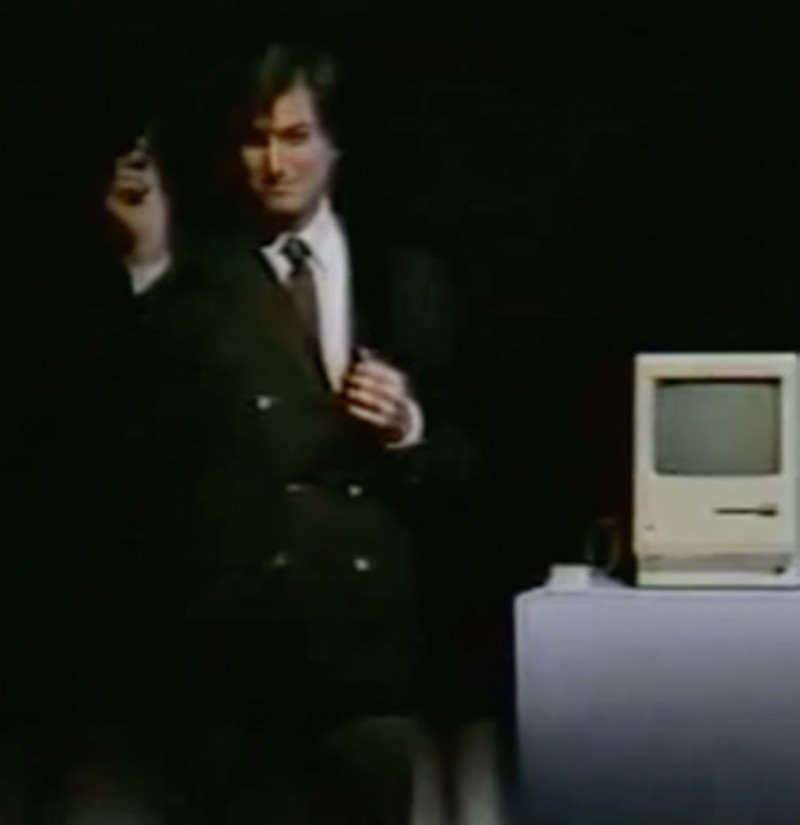
On January 26, 2014, the Computer History Museum released this never-before-seen video of the first public showing of Macintosh. Thirty years ago, on January 30, 1984, Steve Jobs came to Boston to introduce his groundbreaking new computer to members of the world’s largest personal computer organization. In this guest blog, the organizer of that event, Boston Computer Society founder Jonathan Rotenberg, describes the historical context of the evening.
When Steve Jobs returned to Apple in 1996, the company was on the edge of bankruptcy. With Apple’s life hanging by a thread, Steve made some of the boldest moves of his career—taking extraordinary risks with new technologies, partnerships, design concepts, and marketing platforms. It was the beginning of what would become the greatest second act in business history.
Of the many dazzling breakthroughs associated with Steve’s second stint at Apple, one of the most fabled was the ‘Stevenote.’ A ‘Stevenote’ was a keynote speech given by Steve, in which he blew the minds of his audience with a surprising new product introduction. A ‘Stevenote’ was unlike any other product introduction. Steve would share some of the deep, rigorous thinking and philosophy behind each new product—and why Apple’s approach was so radically different from everyone else’s. The ‘Stevenote’ was never just about the product, though; it was also about Steve’s vision of stewardship for the future of technology and its impact on humanity. The drama and tension in each ‘Stevenote’ would build until—with masterful understatement and dramatic staging—Steve would pull the cover off of a paradigm-setting new product.
The ‘Stevenote’ became such a singular phenomenon in American business, entire books were written about it. ‘Stevenotes’ have been endlessly dissected and analyzed by communications experts, marketers, business schools, speechwriters, and journals throughout the world. Today, ‘Stevenote’ is even recognized as a word in Wikipedia.
And—yet—few people realize that the very first ‘Stevenote’ did not happen in 1997. It took place in 1984 when Steve unveiled Macintosh.
In 1984, Macintosh was the most most radical departure ever from the commercial status quo of computing. Before Macintosh, personal computers were a lot like tiny mini computers; their CPUs were almost totally consumed with processing algorithms and paid little attention to the user interface. Steve knew—from Moore’s Law—that microprocessors would double in power every 18 months. But to make a computer accessible to the 235 million Americans who were uncomfortable with computers, he would flip the entire model upside down. He would apply the growing power of microprocessors toward a radical re-conception of human/computer interaction: The graphical user interface.
Today we take for granted the ideas of “point & click” (or “touch & drag”); “cut & paste”; apps that look like real objects (e.g., calendars, maps, calculators, remotes, etc.); mixing text and images in the same document; etc. While a few of these ideas existed in laboratories, no one had ever imagined making them part of a mainstream, affordable, consumer computer—let alone making them all work together seamlessly and effortlessly.
As you watch the video of Steve introducing Macintosh to The Boston Computer Society, the audience is gasping and howling at what they’re seeing. For the first time ever, they are watching a scissor cut bits of one document and paste it into one created in a seemingly incompatible application. Actions that had never been possible before—placing photos and graphs into a word processing document; erasing drawings with a eraser; playing Chess in 3-D; stacking documents like papers on a desk—were suddenly not just possible, they had become instantly intuitive and easy. And yet there was something even bigger still: You didn’t need to memorize a single command. Before Macintosh, it was impossible to use a computer without learning dozens (or hundreds) of arcane commands. Macintosh pioneered the idea of showing you—visually and intuitively—all the possibilities available. You just point to what you want and get it.
Throughout his life, Steve cared more than anything about making the best products in the world. And this is why his presentations to The Boston Computer Society were so unique. BCS members were passionate product users and self-driven pioneers themselves. They understood immediately some of the staggering implications of what Steve and the Mac team had accomplished. Steve seemed to feel at home, open and intimate with BCS members in a way that you don’t see in any other Stevenote.
You can sense Steve’s sheer delight as he deftly pulls the first Macintosh out of its duffle and searches in his double-breasted jacket for the floppy disk to bring it to life:


Steve is at the top of his game in this video, dialoging with BCS members and explaining the thinking and ideas that went into every aspect of Macintosh and Macintosh applications:


It’s hard to believe that Steve was just 28 years old when he delivered his first Stevenote. He had invented something entirely new: An art form at the intersection of showmanship, technology, piercing philosophy, real-life drama, and social manifesto. The Stevenote was utterly unique; it caused a revolution in business communication. To date, no one has ever pulled off a Stevenote like Steve did.